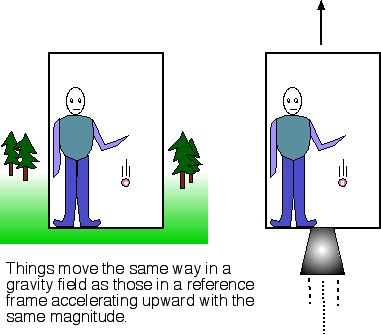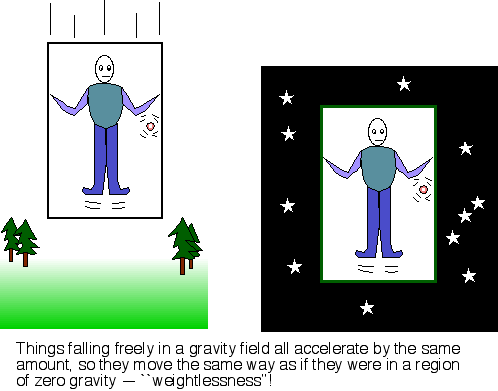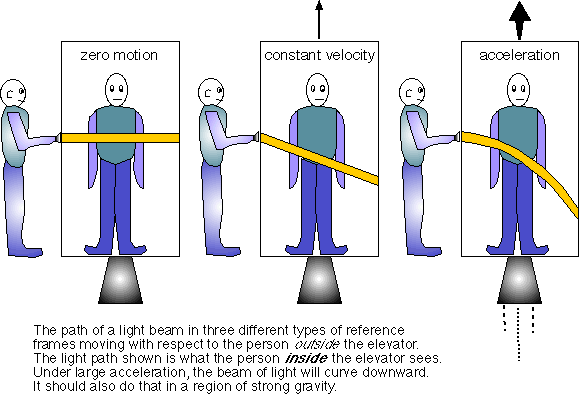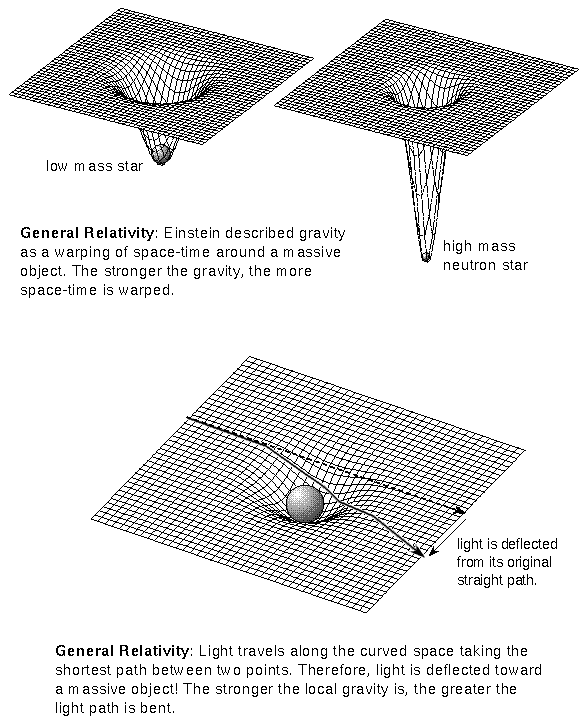
Einstein extended his Special Relativity theory to include gravitation and non-uniform motion. Einstein was intrigued by the fact that the two ways of measuring mass come up with the same value. In Newton's second law of motion, an object's mass is measured by seeing how much it resists a change in motion (its inertia). In Newton's law of gravity, an object's mass is determined by measuring how much gravity force it feels. The fact that the two masses are the same is why Galileo found that all things will fall with the same acceleration.

Part of Einstein's genius was his ability to look at ordinary things from a whole new perspective and logically follow through on the consequence of the insights he gained from his new perspective. He proposed an experiment involving two elevators: one at rest on the ground on the Earth and another, far out in space away from any planet, moon, or star, accelerating upward with an acceleration equal to that of one Earth gravity (9.8 meters/second2). (Modern readers can substitute ``rocket ship'' for Einstein's elevator.) If a ball is dropped in the elevator at rest on the Earth, it will accelerate toward the floor with an acceleration of 9.8 meters/second2. A ball released in the upward accelerating elevator far out in space will also accelerate toward the floor at 9.8 meters/second2. The two elevator experiments get the same result!
Einstein used this to formulate the equivalence principle that would be the foundation of General Relativity. It states that ``there is no experiment a person could conduct in a small volume of space that would distinguish between a gravitational field and an equivalent uniform acceleration''. A consequence of this is that if an elevator is falling freely toward the ground because of gravity, an occupant inside will feel weightless just as if the elevator was far away from any planet, moon, or star. No experiment would help you distinguish between being weightless far out in space and being in free-fall in a gravitational field.

Now suppose someone ``at rest'' outside your elevator way out in space shines a flashlight horizontally across the elevator you occupy toward the far wall of the elevator. If your elevator is at rest, then you will see the beam of light travel in a straight horizontal line. If your elevator is moving at a constant velocity upward relative to the person outside, you will see the beam of light travel in a straight-line path angled downward. The person outside still sees the beam travelling in a horizontal direction. If the elevator is accelerating upward, then the beam will follow a curved path downward relative to you. But if the beam of light curves in the accelerating elevator, then the equivalence principle says that the beam of light should also follow a curved path in a gravitational field.

Light travels along the shortest path between two points in spacetime (a geodesic). If the geodesic is curved, then the path of light is curved. Einstein proposed in his General Relativity theory that what is called gravity is really the result of curved spacetime.

The Earth does not orbit the Sun because the Sun is pulling on it. The Earth is simply following the shortest path in four-dimensional spacetime.
If you have ever taken a long flight, you probably already know that the shortest distance between two cities is not a straight line. Non-stop flights from the United States to Europe fly over parts of Greenland. On a flat map the plane's flight path looks curved, but on a globe, that path is the shortest one! Light travels along a geodesic path between two points in spacetime. Far from any gravity source, the shortest distance is a straight line in three-dimensional space. Near a massive object, the shortest distance is curved in three-dimensional space. Stephen Hawking gives the nice analogy that what we see is like the curved motion of a shadow on the ground from a plane flying in a straight line over hilly terrain.
Einstein's theory of General Relativity is a continuation or extension of Newton's law of gravity. Einstein's theory is not perfect (no scientific theory is absolutely perfect), but it does give a better understanding of the universe. In weak gravity conditions, they will give essentially the same results or predictions. Newton's law of gravity assumes that the geometry of spacetime is flat while Einstein's General Relativity allows any geometry to apply to spacetime. In weak gravity conditions, the curvature of spacetime is so small that Newton's law of gravity works just fine. Since the mathematics of Newton's laws of motion and gravity are simpler than for Einstein's relativity theories, scientists prefer to use Newton's law of gravity for understanding interactions of slow-moving objects in any weak gravity field. As mentioned at the beginning of the chapter, scientists use Newton's laws of motion and gravity to very accurately guide spacecraft in our solar system. For very strong gravitational fields, Newton's description of gravity becomes inadequate. Einstein's theory of General Relativity must be used to describe the gravitational effects.
![]() Go back to previous section --
Go back to previous section --
![]() Go to next section
Go to next section
last updated: 28 May 2001